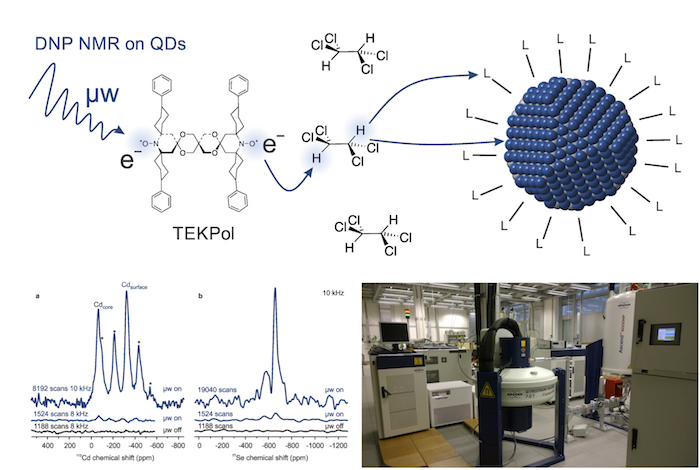Dynamic Nuclear Polarization Surface Enhanced NMR Spectroscopy
Dynamic Nuclear Polarization Surface Enhanced NMR spectroscopy (DNP SENS) is developed as a powerful tool to characterize surface sites, used in energy research.
Energy research relies on the development of functional materials, whose properties are controlled in many instances by the surface states. It is particularly true when catalysis is involved. It is thus essential to gather information about the structure of surface species at a molecular level. The Surface and Interfacial Chemistry laboratory has developed expertise in controlling the surface chemistry of nanomaterials. One of the most powerful methods to obtain atomistic description of surface sites is Nuclear Magnetic Resonance (NMR) spectroscopy. However, it suffers from its intrinsic low sensitivity, which is worsened by the low amount of surface sites. In recent years, the Surface and Interfacial Chemistry group and several collaborators have developed Dynamic Nuclear Polarization Surface Enhanced NMR spectroscopy (DNP SENS) as a powerful tool to characterize surface sites.(1) This technique relies on contacting a material with minute amount of a solution containing a stable radical; irradiation with a high-power single-frequency microwave at 100K allows a polarization of the electrons, which is then transferred to adjacent protons and nuclei. This method increases the sensitivity of NMR by one or two orders of magnitudes and allows expedient characterization of materials. DNP SENS has thus been critical in determining the structure of the interface of oxide materials,(2) the active sites of catalysts like zeolites.(3) More recently it has been used to look at the surface sites of colloid nanocrystal in collaboration with Prof. Kovalenko (see figure below).(4)
More details about the Surface and Interfacial Chemistry group are available
The Head of the laboratory is Prof. Christophe Copéret, member of the ESC.
- Dynamic Nuclear Polarization Surface Enhanced NMR Spectroscopy.
A. J. Rossini, A. Zagdoun, M. Lelli, A. Lesage, C. Copéret, L. Emsley Acc. Chem. Res., 2013, 46, 1942-1951. - Atomic Description of the Interface Between Silica and Alumina in Aluminosilicates Through Dynamic Nuclear Polarization Surface-Enhanced NMR Spectroscopy and First-Principles Calculations. M. Valla, A. Rossini, M. Caillot, C. Chizallet, P. Raybaud, M. Digne, A. Chaumonnot, A. Lesage, L. Emsley, J. van Bokhoven, C. Copéret, J. Am. Chem. Soc. 2015, 137, 10710–10719.
- NMR Signatures of the Active Sites in Sn–b Zeolite. P. Wolf, M. Valla, A.J. Rossini, A. Comas-Vives, F. Núñez-Zarur, B. Malaman, A. Lesage, L. Emsley, C. Copéret, I. Hermans, Angew. Chem. Int. Ed. 2014, 53, 10179–10183.
- The Structure of Colloidal Quantum Dots from Dynamic Nuclear Polarization Surface Enhanced NMR Spectroscopy. L. Piveteau, T.-C. Ong, A. J. Rossini, L. Emsley, C. Copéret, M. V. Kovalenko J. Am. Chem. Soc. 2015, 137, 13964–13971.
